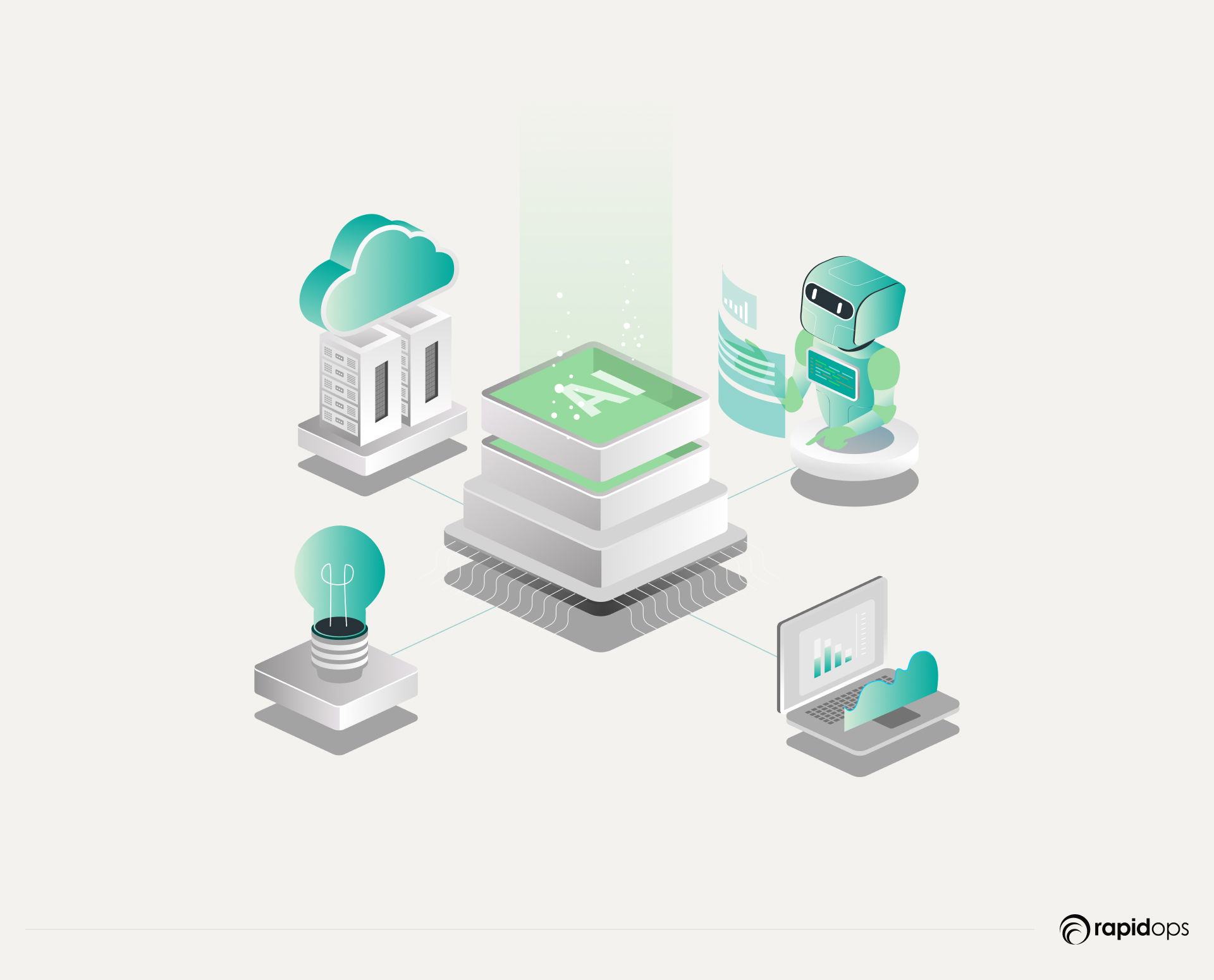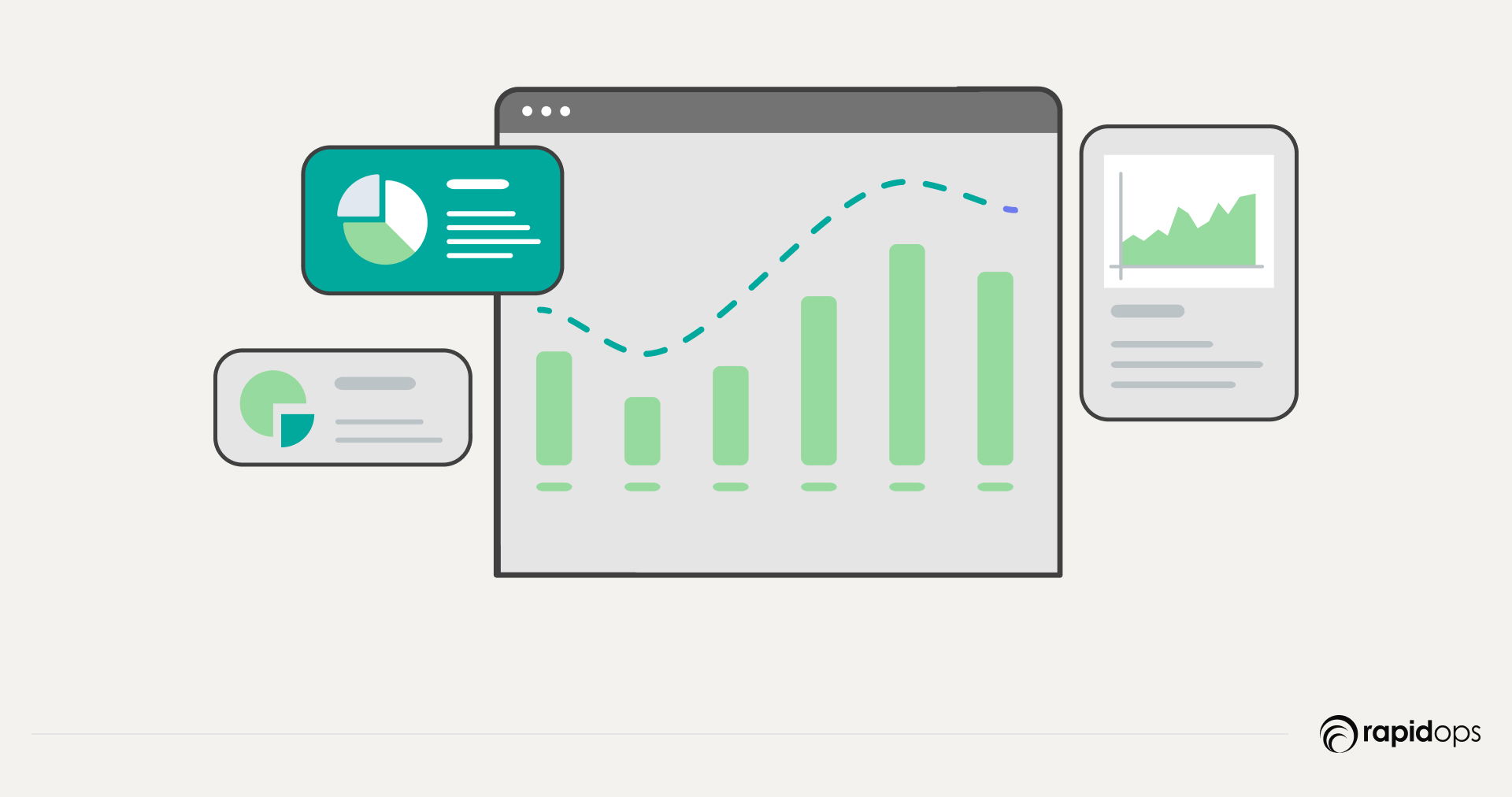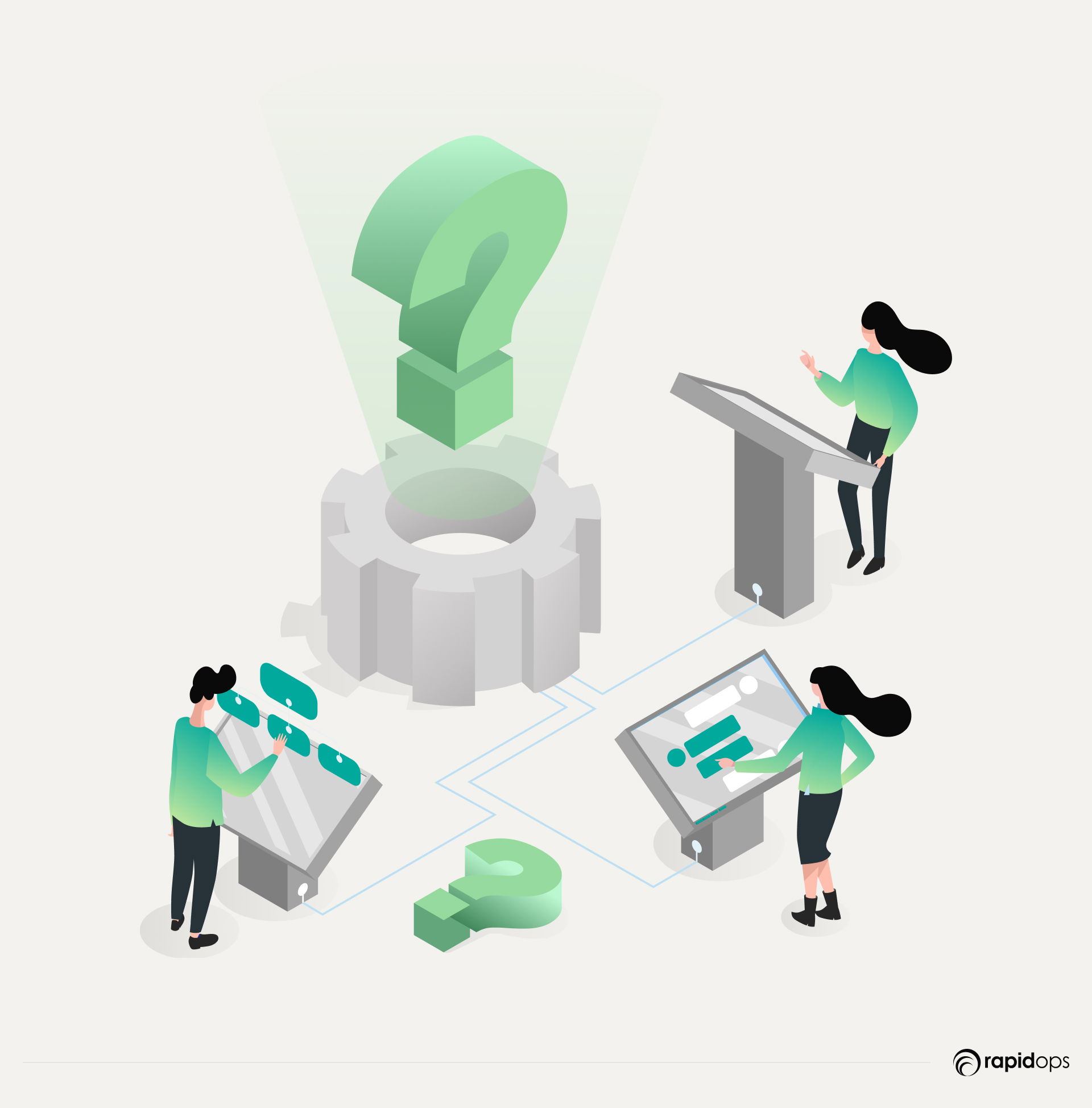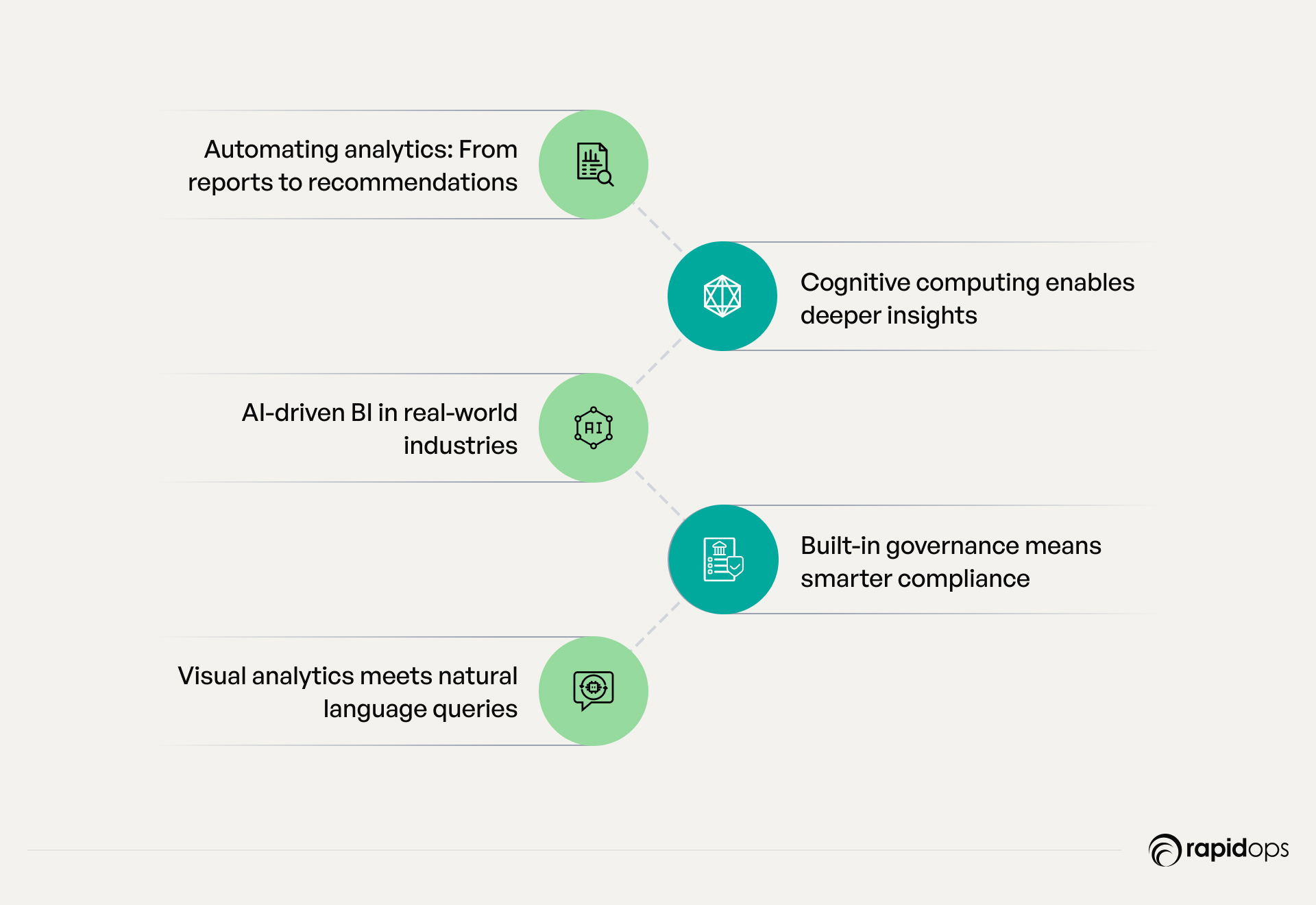- AI
- 25 min read
- March 2025
How AI in Data Visualization Is Transforming Decision Making
Key Takeaways
Think back to those countless meetings spent squinting at spreadsheets, deciphering complex graphs, or drowning in mountains of static reports.
Businesses once relied heavily on these traditional methods, often investing significant effort only to find themselves reacting to events rather than predicting them.
Data visualization existed, of course, but its effectiveness was often limited by manual inputs, static visuals, and a lack of immediate insights.
Enter Artificial Intelligence—an evolution that didn't just change the game, but reinvented it entirely. With AI data visualization, businesses transitioned from struggling to interpret yesterday’s data to confidently forecasting tomorrow’s market movements.
No longer bogged down by static charts and retrospective reports, today's businesses can harness real-time, dynamic visualizations powered by machine learning algorithms and predictive analytics.
Imagine a world where your dashboard doesn't just show what's happening now but forecasts what's likely to occur tomorrow, next week, or even next quarter. With AI-driven visualization, this isn't futuristic speculation—it's everyday reality.
Decision-making has shifted from reactive guesswork to proactive strategic planning, thanks to technology capable of crunching vast amounts of data instantaneously, highlighting hidden trends, and presenting actionable insights clearly and intuitively.
In short, AI has transformed data visualization from a passive display of numbers into an active strategic partner in decision-making. For businesses willing to adapt, this shift marks the beginning of a smarter, more insightful era.
1. How AI enhances data visualization
From static dashboards to intelligent systems
For decades, businesses depended on charts and graphs generated from spreadsheets, business intelligence tools, or manually created dashboards. While these visuals provided some clarity, they were largely static, slow to update, and dependent on human interpretation. This often meant decisions were made reactively—long after opportunities had passed.
AI meets machine learning: Smarter data, faster insights

The arrival of AI data visualization has redefined how businesses interact with their data. AI leverages machine learning in data visualization to analyze massive datasets within seconds, surfacing patterns, correlations, and anomalies that previously required days—or weeks—of manual effort.
But it doesn’t stop there. Artificial intelligence in data analytics takes this one step further by enabling natural language queries. Now, business leaders can ask, “What happened to our Q4 sales in the Asia-Pacific region?” and instantly receive a dynamic, visual answer—no analyst required.
Predictive analytics turns hindsight into foresight

Beyond analyzing what has already happened, AI empowers businesses to look forward. With predictive analytics, organizations can now anticipate future trends—whether it’s customer purchasing behavior, inventory demand, or revenue forecasts. These insights are visualized in real time, helping teams act before problems arise or opportunities are missed.
Real-time, always-on decision support

Traditional BI tools often required scheduled updates and manual data pulls. In contrast, AI-powered dashboards are continuously fed with live data streams. This real-time data analysis means your reports adjust instantly as new information flows in, ensuring leadership teams are always working with the most up-to-date insights.
Scaling with big data visualization

As data volumes grow exponentially, AI plays a critical role in big data visualization. Conventional tools struggle to scale or simplify massive datasets. AI-powered platforms solve this by distilling high-volume, high-velocity data into clean, interactive visual stories—turning complexity into clarity.
From passive observation to strategic advantage
Ultimately, the shift is this: data visualization is no longer a passive reporting function. With AI, it becomes a strategic driver—one that’s always on, always learning, and always ready to deliver business-critical insights. Companies embracing this shift are moving beyond one-dimensional analysis and into an era of data-driven decision making with real-time precision and predictive power.
2. Leveraging machine learning and predictive analytics
Why machine learning is the brain behind modern visualization
In today’s data-saturated business environment, simply knowing what happened is no longer enough. What gives companies a competitive edge is understanding what will happen next—and why.
That’s where machine learning in data visualization steps in. It enables systems to analyze historical data, detect patterns, and refine predictions over time without being explicitly programmed for each scenario.
Forecasting future outcomes, not just explaining the past
Let’s say a retail brand traditionally used past sales reports to understand seasonal trends. With AI data visualization, that same business can now forecast next season’s top-performing products based on consumer behavior, market signals, and emerging digital trends. These predictive analytics give decision-makers a chance to act ahead of the curve rather than play catch-up.
The value here isn’t just speed—it’s accuracy. AI models continuously improve their forecasting capabilities, enabling businesses to prepare for demand spikes, adjust marketing campaigns, and mitigate risks before they materialize.
How AI detects what humans miss: Data mining in action
AI doesn’t just surface the obvious—it uncovers the unexpected. By applying data mining techniques, AI-driven visualization platforms can reveal hidden relationships within your datasets. For example, a logistics company might discover that certain delivery delays correlate with weather patterns, time of day, or even specific supply routes—insights that would be difficult for human analysts to extract manually.
These “invisible” patterns, once visualized, become actionable intelligence that organizations can use to streamline operations, reduce costs, and boost efficiency.
The automation edge: Learning and improving continuously
One of the most transformative aspects of AI in visualization is its ability to self-learn. Traditional predictive models needed manual recalibration, often requiring data scientists to tweak them regularly. In contrast, AI-powered tools use continuous learning to refine their insights automatically as new data flows in.
This shift toward augmented analytics means businesses no longer have to wait for quarterly reports to adjust strategy. AI visualizations provide ongoing intelligence, helping teams make agile decisions based on evolving conditions.
Augmented analytics for real-world strategy
The practical payoff? Businesses equipped with predictive, AI-enhanced visualizations are making faster, smarter decisions—whether it’s predicting customer churn, optimizing procurement cycles, or adjusting pricing strategies in real time
This isn’t guesswork dressed up in charts. It’s data-backed, continually optimized insight that gives businesses the clarity they need to act confidently in uncertain markets.
3. Visual analytics and real-time decision making
Why timing is everything in business decisions

In a fast-moving market, data that’s even a day old can be obsolete. Whether you’re adjusting to customer behavior, responding to a supply chain issue, or catching a sudden market opportunity, real-time data analysis isn’t just an advantage—it’s a necessity. But without AI, visualizing this velocity of data in an actionable format is nearly impossible.
From lagging insights to live business intelligence
Traditional dashboards rely on periodic updates and historical snapshots. AI flips that model. With visual analytics, businesses now receive live streams of data, instantly analyzed, interpreted, and visualized on dynamic dashboards.
For example, an e-commerce company can monitor customer navigation paths, cart abandonment patterns, and live product interest—then adjust discounts or promotions in real time based on what’s happening right now, not what happened last week.
Drilling down with interactive dashboards
AI-powered interactive data dashboards aren’t just prettier charts—they’re responsive, intelligent systems. Users can click into individual metrics, filter by segment, geography, or product category, and surface micro-trends that inform tactical decisions.
What used to take hours of spreadsheet digging or SQL queries can now be done in seconds, with natural language inputs—no technical expertise required.
Self-service BI is changing how teams work
In most businesses, analysts and data scientists used to serve as the gatekeepers of insight. But with self-service BI, powered by AI, cross-functional teams—marketing, sales, operations—can access insights independently, explore datasets intuitively, and take ownership of performance metrics.
The result? Faster decisions, more empowered teams, and fewer bottlenecks between data and action.
Making sense of big data with smarter visuals
AI dramatically improves big data visualization by breaking down massive volumes of information into easy-to-read formats like heatmaps, anomaly detectors, and even AI-generated alerts and recommendations.
Executives don’t need to interpret complex data tables. Instead, they see key takeaways at a glance—and know exactly where to act.
Speed as strategy: Acting in the moment
Businesses leveraging AI-powered visual analytics shift from reactive to proactive. They’re not just monitoring performance—they’re optimizing it in real time. Whether it’s rerouting deliveries, repricing products, or reallocating ad budgets, the ability to make data-driven decisions in the moment is now a defining competitive edge.
4. AI-powered business intelligence (BI) tools
Why traditional BI tools have hit a wall

Business intelligence tools have long been a cornerstone for turning raw data into decision-support insights. But legacy BI systems are often limited by two things: manual effort and static outputs. The insights they deliver are only as timely—and accurate—as the human analysts behind them.
In today’s data-rich environment, that’s no longer enough. What businesses need are systems that interpret data at scale, respond to real-time changes, and generate strategic insights autonomously. That’s where AI-powered BI tools come in.
Automating analytics: From reports to recommendations
With AI embedded into business intelligence, the entire data pipeline is reimagined. These tools can now automate data collection, cleansing, and transformation, eliminating the bottlenecks of manual data prep.
AI doesn’t just summarize data—it identifies trends, spots anomalies, and recommends actions. For instance, if a sales territory is underperforming, an AI-powered BI tool might surface this as a visual alert, link it to declining lead quality, and suggest reallocating budget toward higher-converting channels.
Cognitive computing enables deeper insights
Traditional BI tells you what happened. AI-infused cognitive computing tells you why it happened and what to do next. It simulates human thinking—analyzing data, drawing conclusions, and even improving its logic over time.
For example, a retail chain might use AI to analyze customer behavior across regions. The system could detect that shoppers in urban stores prefer bundle deals, while rural customers lean toward individual items. Based on that, it could recommend region-specific pricing and promotional strategies.
AI-driven BI in real-world industries
Let’s look at how AI-powered BI works in action:
- A logistics firm can track shipment delays in real time and adjust distribution routes dynamically, avoiding bottlenecks.
- A manufacturer can monitor production line performance, receive alerts when efficiency drops, and predict when machinery will need maintenance.
- A financial services provider can identify risk exposure in loan portfolios and auto-generate compliance reports.
These aren’t hypothetical examples. They’re already happening in businesses that have embraced AI-powered data visualization.
Built-in governance means smarter compliance
One of the biggest advantages of AI-enabled BI is data governance. Manual compliance monitoring is resource-heavy and prone to error. AI automatically flags data inconsistencies, ensures adherence to internal standards, and even tracks audit trails for regulatory reporting.
This not only reduces risk but also builds trust—both internally and with external stakeholders.
Visual analytics meets natural language queries
Modern data visualization software doesn’t just present data in engaging formats—it lets users interact with it conversationally. Want to know which region had the highest margin growth last quarter? Just ask. AI processes the request and displays the result as a graph, map, or table—whatever makes the insight easiest to understand.
This level of interactivity shortens the gap between a question and the insight needed to answer it.
From luxury to necessity
What was once considered cutting-edge is quickly becoming table stakes. Businesses that fail to integrate AI-powered BI tools into their data strategy risk falling behind. Those who do stand to benefit from faster, smarter, and more scalable decision-making—driven by tools that think, learn, and adapt as fast as their markets do.
5. Transforming businesses: Real-world case studies in retail, manufacturing, and distribution

The best way to understand the impact of AI data visualization is to see it in action. Across retail, manufacturing, and distribution, businesses are using AI-powered visualization to predict demand, optimize supply chains, and make real-time strategic decisions that reduce costs, increase efficiency, and maximize profitability.
Let’s break it down.
Retail: AI-powered demand forecasting and inventory management
The Challenge:
Retailers have always struggled with demand unpredictability—too much stock leads to wastage and financial losses, while too little stock results in lost sales and customer dissatisfaction.
AI in Action:
Retail giants like Levi Strauss & Co. and Zara have revolutionized their supply chain with AI-powered demand forecasting and inventory optimization.
Levi Strauss & Co. uses machine learning in data visualization to analyze past purchase behaviors, seasonal trends, and even external factors (such as economic shifts and weather patterns) to predict customer demand with high accuracy. This ensures that popular sizes and styles are always in stock, leading to:
- 15% fewer stock shortages
- 20% lower operational costs
Zara, a fast-fashion leader, has integrated AI-driven big data visualization to track store-level sales in real time. This allows them to adjust production schedules and logistics dynamically. Their AI-powered dashboard:
- Monitors customer preferences by location
- Detects emerging trends from digital interactions
- Provides real-time insights into warehouse stock levels
Process Flow: AI-powered retail forecasting
- AI collects point-of-sale (POS) data, social media trends, and past sales records.
- Machine learning algorithms detect sales patterns and customer behavior shifts.
- AI-driven interactive data dashboards visualize which products need restocking and which should be discounted.
- Automated logistics and smart warehouses adjust procurement and distribution based on demand projections.
This data-driven decision-making approach has increased Zara’s operational efficiency by 30% and improved inventory turnover rates.
Manufacturing: AI for Smart Production and Supply Chain Optimization
The Challenge:
Manufacturers often suffer from delayed production cycles, inefficient workflows, and unpredictable supply chain disruptions. Traditional methods rely on manual reporting, leading to slower response times and operational inefficiencies.
AI in Action:
Walmart’s Digital Twin Technology revolutionized its supply chain efficiency by implementing AI-powered real-time data analysis. Using "digital twin" simulations, Walmart creates virtual models of its entire supply chain, allowing them to:
- Test new layout designs and operational strategies
- Predict bottlenecks and inefficiencies before they occur
- Improve in-store experience with automated stocking solutions
Results:
- 40% reduction in supply chain delays
- Faster distribution of high-demand products
Amarra, a global apparel manufacturer, leveraged AI-powered data visualization software to optimize its production process. By integrating AI tools, Amarra:
- Reduced overstocking by 40%
- Automated production schedules based on predictive analytics
- Used AI chatbots for 70% of customer inquiries, improving response time and engagement
Process flow: AI-powered manufacturing optimization
AI analyzes factory production rates, equipment performance, and supplier delivery schedules.
Visual analytics tools identify delays and suggest optimal production shifts.
AI-generated predictive analytics ensure that raw materials are ordered just in time, preventing stockouts or excess inventory.
Machine learning in data visualization predicts potential equipment failures, ensuring proactive maintenance rather than costly repairs.
Distribution: AI for Route Optimization and Logistics Management
The Challenge:
Distributors face rising transportation costs, inefficient routing, and unpredictable delivery times due to supply chain complexities. AI is solving these problems with route optimization and predictive logistics.
AI in Action:
Neoteros and Arrow Electronics deployed AI-driven foot traffic analytics to track customer movement inside retail stores and optimize shelf placement and supply chain decisions. Their AI-powered business intelligence (BI) tools enabled:
- Improved in-store navigation for customers
- Optimized stock placement based on high-traffic zones
- Better forecasting for distribution schedules
Major distributors are now using augmented analytics to:
- Reduce warehouse-to-store transit times by analyzing historical delivery patterns
- Optimize truck loads and fuel efficiency by predicting road congestion
- Lower inventory storage costs with AI-powered demand forecasting
Process flow: AI-powered distribution management
- AI gathers logistics data from GPS tracking, warehouse reports, and supply chain events.
- AI-powered interactive data dashboards present real-time insights on delays, stock levels, and demand fluctuations.
- Predictive analytics model alternative routes, delivery schedules, and fleet optimization strategies.
- AI dynamically adjusts supply chain operations, ensuring faster, cost-effective deliveries.
Challenges and best practices for adopting AI in data visualization
AI-powered data visualization is a game-changer, but implementing it effectively isn’t as simple as flipping a switch. While businesses recognize the potential of AI data visualization to drive smarter decision-making, many struggle with data complexity, integration challenges, and workforce adaptability. Here’s an unfiltered look at the biggest roadblocks and best strategies to overcome them.
Challenge 1: Managing data overload and complexity
The data explosion is real. Businesses today generate and collect massive amounts of structured and unstructured data—from customer transactions and social media activity to IoT sensor data and supply chain records. Without a robust strategy, companies can easily drown in their own data rather than extract meaningful insights.
Companies that fail to manage data quality risk making poor business decisions based on flawed or incomplete information.
Best practice: Implement AI-powered data governance
The key to managing big data visualization is structured data governance—ensuring data is clean, reliable, and ready for AI-driven analysis. AI can automate data classification, error detection, and anomaly correction, making raw data usable and actionable.
- Deploy AI-enhanced data pipelines to filter, clean, and standardize data before it enters visualization dashboards.
- Use real-time data analysis tools that continuously update and refine datasets, eliminating outdated or redundant information.
- Ensure compliance with data privacy regulations by integrating AI-based security measures to monitor sensitive information.
Challenge 2: Lack of Integration with Existing Systems
Most businesses don’t have the luxury of starting from scratch with their tech stack. Many rely on legacy ERP, CRM, and BI systems that aren’t built to handle AI-driven insights. AI-powered business intelligence (BI) tools can only be effective if they integrate seamlessly into existing workflows, databases, and analytics ecosystems.
Companies that fail to integrate AI visualization into their existing ecosystem risk operational silos and data fragmentation.
Best Practice: Choose scalable, AI-ready BI platforms
To avoid disruption, businesses should opt for AI-driven data visualization software that integrates with their current data lakes, CRM, and ERP systems.
- Prioritize platforms that support API connectivity for smooth interoperability between old and new systems.
- Leverage AI-powered middleware that can extract, transform, and load (ETL) data without disrupting existing workflows.
- Adopt self-service BI solutions that empower non-technical teams to access AI-driven insights without heavy reliance on IT.
Challenge 3: Resistance to AI adoption and workforce upskilling
AI doesn’t replace human intelligence—it enhances it. But without proper training and change management strategies, employees often see AI as a threat rather than a tool for productivity.
Businesses that invest in AI upskilling gain a workforce that can leverage AI-driven insights effectively rather than resist them.
Best practice: Invest in AI literacy and upskilling
AI is only as good as the people using it. To drive adoption, businesses must ensure employees understand AI-driven insights and trust the technology.
- Launch AI training programs that educate employees on how to interpret AI-driven dashboards and predictive analytics.
- Encourage a data-driven culture by embedding data storytelling techniques into executive decision-making processes.
- Start with pilot projects in key departments (such as finance, sales, and supply chain) before scaling AI visualization company-wide.
Challenge 4: The cost factor – Balancing AI investment with ROI
AI-powered predictive analytics and visual analytics solutions can be costly, especially for mid-sized businesses. The challenge isn’t just in adopting AI, but in ensuring that the return on investment (ROI) justifies the cost.
AI should be seen as an investment, not an expense. Companies that implement AI in high-impact areas first will see faster ROI, making it easier to expand AI-driven decision-making company-wide.
Best practice: Start with high-impact use cases
Instead of overhauling entire analytics systems, businesses should prioritize AI implementation in areas that yield fast, measurable returns.
- Retailers can start with AI-driven demand forecasting to improve inventory accuracy and prevent overstocking.
- Manufacturers can integrate AI into supply chain analytics to minimize downtime and optimize logistics.
- Distributors can implement AI-powered route optimization to reduce fuel costs and improve delivery times.
Challenge 5: AI bias and ethical concerns
AI is powerful, but it’s not infallible. Bias in AI models can lead to skewed insights, inaccurate predictions, and even compliance risks. If AI-driven data visualization software isn’t designed to eliminate biases, businesses may unknowingly reinforce incorrect assumptions and flawed decision-making.
Companies that don’t address AI bias risk legal challenges, reputational damage, and poor strategic decisions.
Best practice: Ensure AI transparency and ethical AI usage
- Use explainable AI (XAI) models that allow businesses to understand how AI generates insights.
- Regularly audit AI-driven BI tools to identify and correct potential biases in data interpretation.
- Incorporate human oversight in AI-driven decision-making processes to ensure fairness and accuracy.
Conclusion: AI data Visualization—from insight to action
The AI revolution in data visualization is not just about presenting numbers in an attractive format—it’s about turning raw data into strategic intelligence that drives business growth. Today, companies across retail, manufacturing, and distribution are already seeing tangible ROI by integrating predictive analytics, real-time data analysis, and AI-driven business intelligence (BI) tools into their operations.
But adopting AI-powered visualization isn’t just about the technology—it’s about ensuring that your business is ready to extract, interpret, and act on AI-generated insights. That’s where expert guidance makes all the difference.
What’s next for your business?
- Are you struggling with complex, disconnected data and want to unify insights in real time?
- Do you want to predict market trends, optimize supply chains, or personalize customer experiences using AI?
- Are you looking for a clear roadmap to integrate AI-powered data visualization into your existing workflows?
If your business is ready to move beyond outdated dashboards and harness AI-driven data visualization for faster, smarter, and more impactful decision-making, let’s talk.
Our AI experts specialize in helping businesses implement AI-powered data visualization in a way that’s scalable, cost-effective, and customized to your industry needs. Book a free consultation today and let’s explore how AI can elevate your data strategy, enhance your decision-making, and drive real business value.
What’s Inside
- 1. How AI enhances data visualization
- 2. Leveraging machine learning and predictive analytics
- 3. Visual analytics and real-time decision making
- 4. AI-powered business intelligence (BI) tools
- 5. Transforming businesses: Real-world case studies in retail, manufacturing, and distribution
- Challenges and best practices for adopting AI in data visualization
- Conclusion: AI data Visualization—from insight to action




